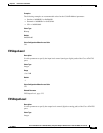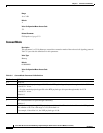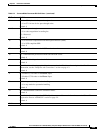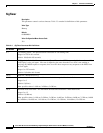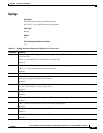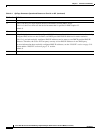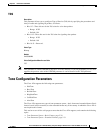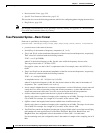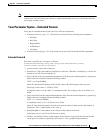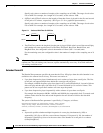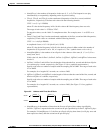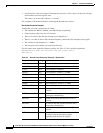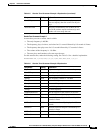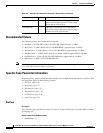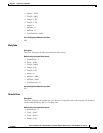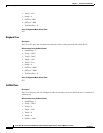
5-31
Cisco ATA 186 and Cisco ATA 188 Analog Telephone Adaptor Administrator’s Guide for MGCP (version 3.0)
OL-4803-01
Chapter 5 Parameters and Defaults
Tone Configuration Parameters
Note All tones are persistent (until the Cisco ATA changes state) except for the call-waiting tone and the
confirm tone. The call-waiting tone, however, repeats automatically once every 10 seconds while the
call-waiting condition exists.
Tone Parameter Syntax—Extended Formats
Two types of extended format exist for the Cisco ATA tone parameters:
• Extended Format A, page 5-31—This format can be used for the following tone parameters:
–
DialTone
–
BusyTone
–
RingbackTone
–
CallWaitTone
–
AlertTone
• Extended Format B, page 5-32—This format can be used only for the ReorderTone parameter.
Extended Format A
Each tone is specified by 11 integers, as follows:
parametername:NumOfFreqs,Tfreq1,Tamp1,Tfreq2,Tamp2,NumOfOnOffPairs,OnTime1,
OffTime1,OnTime2,OffTime2,TotalToneTime
• parametername is the name of the tone.
• NumOfFreqs = 100 + the number of frequencies in the tone. (Therefore, NumOfFreqs = 101 for one
frequency, and 102 for two frequencies.)
• Tfreq1 and Tfreq2 are the transformed frequencies of the first and second frequencies, respectively.
Their values are calculated with the following formula:
32767 * cos (2*pi*F/8000)
where F is the desired frequency in Hz. Set this value to 0 if the frequency does not exist.
The range of each value is –32768 to 32767.
For negative values, use the 16-bit 2’s complement value. For example, enter –1 as 65535 or as
0xffff.
• Tamp 1 and Tamp2 are the transformed amplitudes of the first and second frequencies, respectively.
Their values are calculated with the following formula:
32767 * A * sin(2*pi*F/8000)
A (amplitude factor) = 0.5 * 10^((k+10-(n-1)*3)/20)
where F is the desired frequency in Hz, k is the desired volume in dBm, and n is the number of
frequencies. The ^ symbol means to the order of.
• NumOfOnOffPairs is the number of on-off pairs in the cadence of the tone.
Valid values are 0, 1 and 2. Use 0 if the tone is steady.
• OnTime1 and OnTime2 values are the lengths of time the tone is played for the first and second
on-off pairs of a cadence, respectively. (See Figure 5-1 for a graphical representation.)



